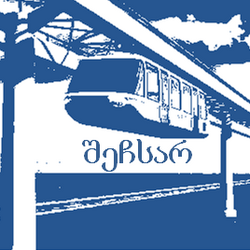Shesar
Shesar
| |
| | |
| Locale | |
| Type | Suspended pneumatic monorail network |
| Lines | 4 (+3 in construction) |
| No. of stations | 39 (+75 in construction) |
| Daily Ridership | ? million (average) |
| Began Operation | 2006 |
| Vehicles | TBC |
| System length | TBC |
| Operator (s) | SARK |
| Average speed Top speed |
250 km/h (average) 350 km/h (top speed) |
| 250px Current Shesar system | |
The Shesar (Kartvelian: შეჩსარ) (abbreviation Kartvelian: შეჩერებულია სარკინიგზო, shecherebulia sarkinigzo, literally "suspended railway"), is a national high speed monorail transportation network in Varkana.
Technology[edit | edit source]
The Shesar monorail is a new technology for public transit based on the engine-wheel introduced in 1994 by Roman Dzindzichashvili. Each transport unit (called shuttle), the size of a bus, is self-powered by 16 next Generation electric engine-wheels (adapted to the rail) and rolling on a rail-shaped inverted T. Each shuttle can carry 60 to 75 passengers comfortably seated or 10 tonnes of cargo in refrigerated containers or not. These shuttles run in the opposite direction, in suspended beneath two rails supported at about 12.5 meters above the ground mode. These rails are supported by an infrastructure consisting of a continuous steel truss (triangular structure) which is supported by pylons and firmly anchored to the ground spaced by about 40 to 50 meters from each other.
Its infrastructure is able to fight ground frost, and its vehicles can brave any storm since the rails and wheel motors are covered with a metal dome that protects from rain, snow and ice, and thus, requires no snow removal in winter in alpine areas. The system is fully electrified and non-polluting. The suspended monorail Shesar is a bidirectional traveling with high speed units each side of the structure on steel rails supported by a high infrastructure of 15 meters, while the underside of the shuttle 10 meters from the ground.
The Shesar can be installed virtually anywhere: in the median of a highway, passing over viaducts, following an existing road, roll in the middle of an urban boulevard, set door overhang an existing bridge, or pass over a railway. Unlike other monorails, it can travel in "three dimensions", that is to say up or down the hills, like a bus because it runs on high performance tires. Shuttles are controlled remotely and require no individual driver, while the passenger vehicles may have an attendant available to monitor operations.
